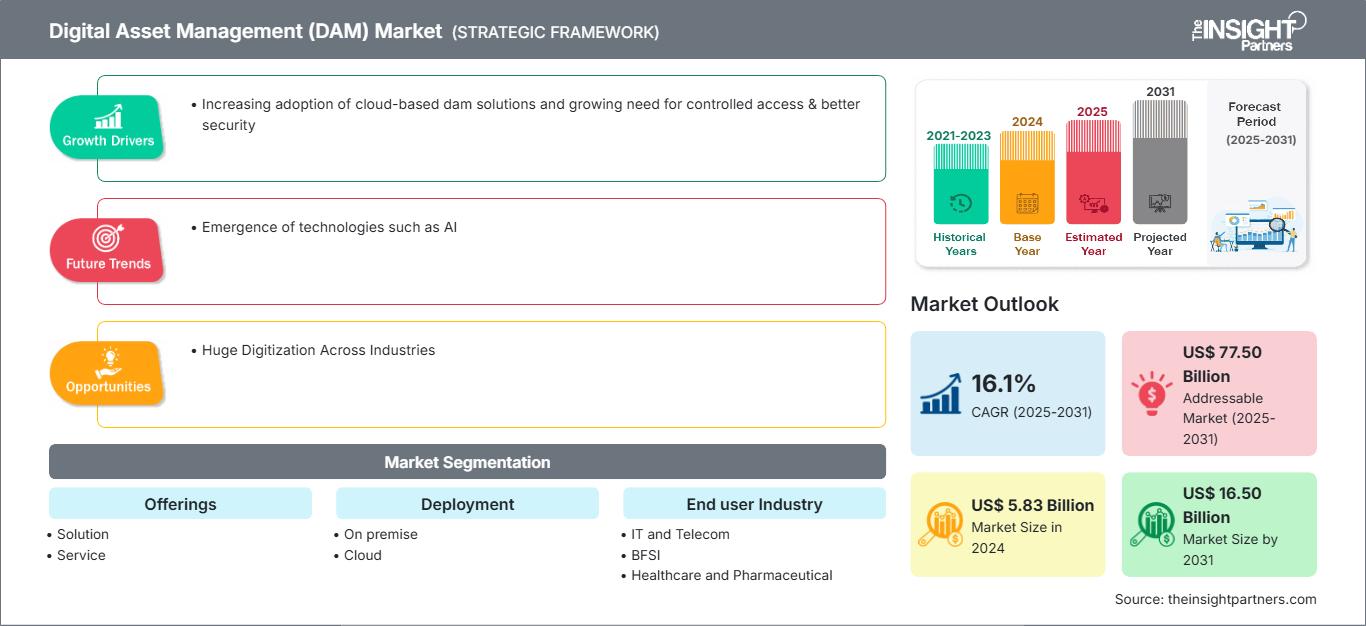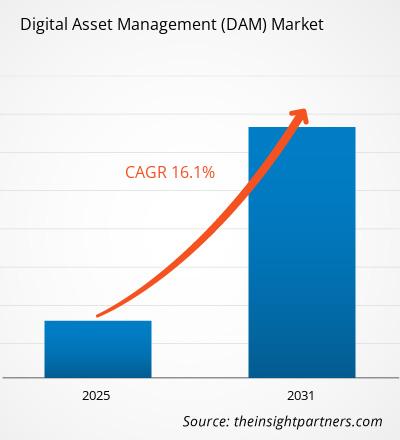デジタル資産管理市場は、2031年までに2,4936.7億米ドルに達すると予測されています。市場は2025年から2031年にかけて年平均成長率(CAGR)18.0%を記録すると予想されています。AIなどの技術の台頭は、今後も市場の主要なトレンドであり続けるでしょう。
デジタルアセットマネジメント(DAM)市場分析
ここ数年、デジタルアセットマネジメント(DAM)市場は、企業におけるデジタル化の進展と効率的なコンテンツ管理ソリューションへの大きな需要により、堅調な成長を遂げてきました。デジタルコンテンツの増加、オープンソースDAMへの大きな需要、データオーケストレーションの進歩などは、デジタルアセットマネジメント(DAM)市場の成長を牽引する要因です。技術革新への注目の高まりとクラウドベースのDAMソリューションの採用拡大は、デジタルアセットマネジメント(DAM)市場の成長にとって魅力的な機会となる要因の一つです。さらに、DAMにおける機械学習とAI機能の拡大、そしてデジタルアセットマネジメントにおけるデータ分析とインサイトの重要性の高まりは、予測期間中のデジタルアセットマネジメント市場の成長を促進すると予測されています。
デジタルアセットマネジメント(DAM)市場概要
デジタル資産管理(DAM)は、動画、画像、文書、その他のマルチメディアコンテンツといったデジタル資産を保存、整理、取得、カタログ化、そして配信するシステムです。DAMシステムは通常、バージョン管理、作成、承認、配信といったデジタル資産のライフサイクル管理ツールを提供します。DAMの主な目的は、デジタル資産を一元管理するリポジトリを提供することです。これにより、チームは必要な資産にアクセスして探し出し、異なるプラットフォームやチャネル間で資産が一貫して適切に使用されるようにすることができます。さらに、DAMは、コラボレーション、ワークフローの効率化、そして資産の再利用性を高め、冗長なストレージや資産の複製にかかるコストを削減します。DAMシステムは、中小企業から大企業まで、様々な組織で活用できます。メディア・エンターテイメント、政府機関、教育機関、マーケティングなど、様々な業界の要件に合わせてカスタマイズすることも可能です。
このレポートの一部、国レベルの分析、Excelデータパックなど、あらゆるレポートを無料でカスタマイズできます。また、スタートアップや大学向けのお得なオファーや割引もご利用いただけます。
デジタルアセットマネジメント(DAM)市場:戦略的洞察

-
このレポートの主要な市場動向を入手してください。この無料サンプルには、市場動向から見積もりや予測に至るまでのデータ分析が含まれます。
デジタルアセットマネジメント(DAM)市場の推進要因と機会
クラウドベースのDAMソリューションの採用増加が市場を有利に導く
デジタル資産管理業界を牽引する大きな要因の一つは、クラウドベースのデジタル資産管理ソリューションの導入拡大です。クラウドベースのデジタル資産管理ソリューションは、柔軟性、拡張性、アクセシビリティなど、従来のオンプレミスソリューションに比べて多くのメリットを提供します。クラウドベースのDAMを利用することで、組織はデジタル資産を安全かつ一元管理された場所に保管し、どこからでもアクセスできるようになります。これにより、デバイスや場所を問わず、チーム間で資産を共有し、共同作業を行うことが容易になります。さらに、クラウドベースのDAMソリューションは拡張性に優れているため、デジタル資産ライブラリの拡大に合わせてストレージ容量を拡張できます。これにより、従来のオンプレミスソリューションのように、ハードウェアやインフラへの多額の投資が必要となる初期費用を回避できます。
さらに、クラウドベースのDAMソリューションは非常に柔軟性が高く、様々な業界や組織の特定のニーズに対応できる幅広いカスタマイズオプションを提供しています。また、機械学習やAIといった高度な機能も提供しており、分類やタグ付けなど、デジタル資産管理に関連する様々なタスクの自動化を支援します。さらに、クラウドベースのDAMソリューションの導入拡大は、DAM業界の成長と発展を促進しています。これにより、組織はワークフローを進化させ、デジタル資産の価値を向上させることができます。
業界全体での大規模なデジタル化
COVID-19パンデミックの影響で、様々な業界でリモートワークへの大きな転換が起こりました。在宅勤務のトレンドは、組織におけるデジタル化の重要性を高めました。在宅勤務の従業員はデジタル資産へのアクセスを必要としており、デジタル資産管理ソリューションの需要が高まっています。企業は、マーケティングトレンドの変化に伴い増加するデジタル資産に対応するため、デジタル資産管理ソリューションを活用しています。
デジタルアセットマネジメント(DAM)市場レポート:セグメンテーション分析
デジタル資産管理(DAM)市場分析の導出に貢献した主なセグメントは、提供、展開、ビジネス機能、および最終用途産業です。
- デジタルアセットマネジメント(DAM)市場は、提供内容に基づいてソフトウェアとサービスに分かれています。2023年にはソフトウェアセグメントがより大きな市場シェアを占めました。
- デジタルアセットマネジメント(DAM)市場は、種類別にクラウド型とオンプレミス型に分けられます。2023年にはクラウド型がより大きな市場シェアを占めました。
- 事業機能別に見ると、市場は人事(HR)、営業・マーケティング、情報技術、その他に分類されています。2023年には情報技術セグメントが最大の市場シェアを占めました。
- エンドユーザー産業の観点から見ると、市場はIT・通信、BFSI、ヘルスケア・製薬、製造、政府機関、その他に分類されています。IT・通信セグメントは、予測期間中に最も高いCAGRで成長すると予想されています。
デジタルアセットマネジメント(DAM)の地域別市場シェア分析
デジタル資産管理 (DAM) 市場レポートの地理的範囲は、主に北米、アジア太平洋、ヨーロッパ、中東およびアフリカ、南米および中米の 5 つの地域に分かれています。
アジア太平洋地域は、予測期間中に最も高い成長率を示すと予想されています。インドは、言語、コンテンツ、その他の要件に関連する複雑さから、メディア・エンターテインメントプロバイダーにとって管理が難しい国と考えられています。そのため、こうした複雑さに対応するために、デジタルアセットマネジメント(DAM)が広く導入されています。中国では、企業のデジタルトランスフォーメーションがトレンドとなっています。2021年10月には、ハーバード大学出身のデザイナーが、中国のテクノロジー業界におけるエンタープライズソフトウェアを次の大きなチャンスと見なす投資家の支援を受け、コンテンツマーケティングプラットフォームでユニコーン企業を設立しました。
デジタルアセットマネジメント(DAM)市場の地域別分析
The Insight Partnersのアナリストは、予測期間を通じてデジタルアセットマネジメント(DAM)市場に影響を与える地域的なトレンドと要因を詳細に解説しています。このセクションでは、北米、ヨーロッパ、アジア太平洋、中東・アフリカ、中南米におけるデジタルアセットマネジメント(DAM)市場のセグメントと地域についても解説します。
デジタルアセットマネジメント(DAM)市場レポートのスコープ
| レポート属性 | 詳細 |
|---|---|
| 2024年の市場規模 | 20億米ドル |
| 2031年までの市場規模 | 2,4936.7億米ドル |
| 世界のCAGR(2025年~2031年) | 18.0% |
| 履歴データ | 2021-2023 |
| 予測期間 | 2025~2031年 |
| 対象セグメント |
提供物によって
|
| 対象地域と国 |
北米
|
| 市場リーダーと主要企業の概要 |
|
デジタルアセットマネジメント(DAM)市場のプレーヤー密度:ビジネスダイナミクスへの影響を理解する
デジタルアセットマネジメント(DAM)市場は、消費者の嗜好の変化、技術の進歩、製品メリットへの認知度の向上といった要因によるエンドユーザー需要の高まりに牽引され、急速に成長しています。需要の高まりに伴い、企業は提供サービスの拡充、消費者ニーズへの対応のためのイノベーション、そして新たなトレンドの活用を進めており、これが市場の成長をさらに加速させています。

- デジタルアセットマネジメント(DAM)市場のトップキープレーヤーの概要を入手
デジタルアセットマネジメント(DAM)市場のニュースと最近の動向
デジタルアセットマネジメント(DAM)市場は、主要な企業出版物、協会データ、データベースなどを含む一次調査および二次調査を経て、定性・定量データを収集することで評価されます。デジタルアセットマネジメント(DAM)市場における動向のいくつかを以下に示します。
- ABBは、計装機器向けデジタル資産パフォーマンス管理プラットフォームを発表しました。ABB Ability™ SmartMaster資産パフォーマンス管理プラットフォームは、現場機器からの診断データを収集、分析、検証し、水道、廃水処理、化学、石油・ガスなどの産業における運用効率の向上に貢献します。(出典:ABB、プレスリリース、2023年11月)
- デジタルエクスペリエンス企業のAcquiaは、デジタルアセット管理プラットフォーム「Acquia DAM(Widen)」の機能強化を発表しました。これには、クリエイティブワークフローを支援する強力な人工知能(AI)チャットボットが含まれます。(出典:Acquia、プレスリリース、2023年5月)
デジタルアセットマネジメント(DAM)市場レポートの対象範囲と成果物
「デジタルアセットマネジメント(DAM)市場規模と予測(2021~2031年)」レポートでは、以下の分野を網羅した市場の詳細な分析を提供しています。
- 調査対象範囲に含まれるすべての主要市場セグメントにおける、世界、地域、国レベルでのデジタル資産管理(DAM)市場規模と予測
- デジタル資産管理(DAM)市場の動向、および推進要因、制約、主要な機会などの市場動向
- 詳細なPEST/ポーターの5つの力とSWOT分析
- 主要な市場動向、世界および地域の枠組み、主要プレーヤー、規制、最近の市場動向を網羅したデジタル資産管理(DAM)市場分析
- 市場集中、ヒートマップ分析、主要プレーヤー、デジタル資産管理(DAM)市場の最近の動向を網羅した業界の展望と競争分析
- 詳細な企業プロフィール
- 過去2年間の分析、基準年、CAGRによる予測(7年間)
- PEST分析とSWOT分析
- 市場規模価値/数量 - 世界、地域、国
- 業界と競争環境
- Excel データセット
最新レポート
お客様の声
購入理由
- 情報に基づいた意思決定
- 市場動向の理解
- 競合分析
- 顧客インサイト
- 市場予測
- リスク軽減
- 戦略計画
- 投資の正当性
- 新興市場の特定
- マーケティング戦略の強化
- 業務効率の向上
- 規制動向への対応






















 無料サンプルを入手 - デジタルアセットマネジメント(DAM)市場
無料サンプルを入手 - デジタルアセットマネジメント(DAM)市場